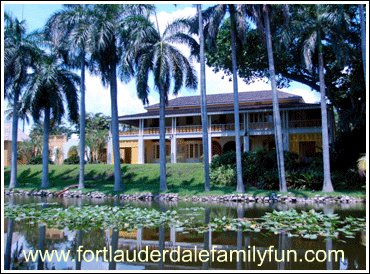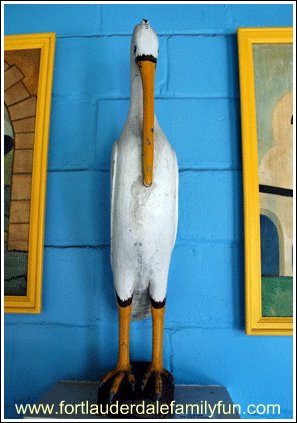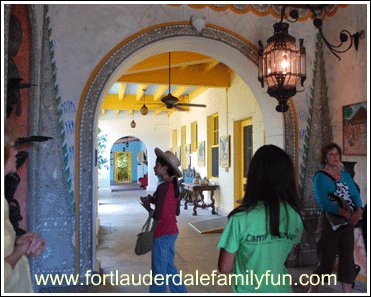The Bonnet House
For Love and Art
You can see the pine trees lined along the iron gates of the Bonnet House from A1A, next to Fort Lauderdale beach , just south of Sunrise Boulevard. But if you didn’t know it was there you might wonder what it is (A park? Someone’s property?) and not think any more of it.
The Bonnet House is located in the oddest of places – right in the middle of expensive homes and a few multi-story buildings, two roads with rushing traffic and the busiest and most popular beach in the county.
To get here, turn into North Birch Road from Sunrise Boulevard and follow the signs to the Bonnet House. Incidentally, the Hugh Taylor Birch Park’s entrance is on the other side of Sunrise Boulevard facing North Birch Road.

Hugh Taylor Birch was a prominent attorney from Chicago who ended up buying 3 ½ miles of beachfront property by 1895. In 1919, he gave a portion of it as a wedding present to his daughter, Helen Birch, and her husband Frederick Clay Bartlett, an architect and a skilled artist also from Chicago.
On this land, the newlywed couple started building the Bonnet House estate in 1920 and planned to use it as their winter home to escape the Midwestern cold and where they can pursue their creative interests in painting, writing and music.
But in 1925, Helen tragically died of cancer and all work on the house stopped for many years after that.
In 1931, Frederick married Evelyn Fortune Lilly (daughter of pharmaceutical giant founder, Eli Lilly) and the Bonnet House was given another chance in life. Much of what can be seen today of the Bonnet House is what Frederick and Evelyn created together in the 1930s and 1940s.
The plantation style house was designed and built by Frederick. He meant for it to be truly lived in with comfort, creativity and relaxation unlike the palatial mansions being built in Palm Beach during the same time by the Bartlett’s counterparts.
The whole estate has 14 different points of interest according to the visitor guide. All of them have a special place in the tour of the estate but here are the ones that I feel are the true highlights.
The most interesting attraction is of course, the main house itself. The house is painted a bright, cheery yellow with an open courtyard inside with an aviary and fountains in the middle.
The house tour consists of going to the different rooms that contains the paintings and other artwork that the couple accumulated over the years and during their travels together.
They clearly had a passion for art, which can be seen in their collections. At the end of the house tour is the gallery showing the original paintings made by Evelyn.
Several whimsical statues of animals decorate the courtyard. This gives the house an almost playful atmosphere. At the very least, it will make you smile!

Remember that no photography is allowed in the rooms since the paintings are sensitive to the light from the camera’s flash. Photography is allowed in the outside courtyards and the gardens. Also be careful not to touch any of the artifacts and statues in the rooms and courtyard. It’s tempting because it’s all out there and still looks as if someone still lives here. But the Bonnet House is indeed a museum and everyone has to abide to its museum rules.
Another highlight is the Orchid House that displays the house’s orchids when they are in bloom. Evelyn loved these beautiful and tenacious flowers and had a collection of several hundreds of orchids. Interesting to also see is the Shell Museum Complex that includes different sea shells from around the world.
And then there are the surrounding gardens of the house. There is a slough (pronounced slew) in the property, which is almost like a pond or a small lake. The bonnet lily grows in this slough, which is where the house got its name from.

The Bonnet House estate sits on what is called a barrier island. These islands have the ocean on one side and the Intracoastal Waterway on the other. Barrier islands protect the mainland from fickle Mother Nature and at the same time provide a home to the subtropical flora and fauna.
In fact, all of
Fort Lauderdale’s beaches
are located on these barrier islands (think about that the next time you go over one of the many bridges that go over the Intracoastal), but their natural state has now vanished due to development.
The Bonnet House is now the only place where we can see what these barrier islands must have looked liked a long time ago. There is a surprising aerial photograph of the estate where you can see that it is the only parcel of vegetation left surrounded by modern buildings.
Because Evelyn loved the house and grounds so much, she donated the estate to the Florida Trust for Historic Preservation to make sure that it will remain much as it was and that the generations who come after will be able to enjoy it much the same way as she and her beloved husband did.
Take some time to visit this interesting piece of Fort Lauderdale history and see what life was like back then before the development, the tourist seasons and the bustling crowd. Then off you go out onto the busy streets and back again into the modern life we live in today.
Bonnet House
900 North Birch Road
Fort Lauderdale, FL 33304-3326
Tel : 954-563-5393
www.bonnethouse.org
Have You Been To The Bonnet House?
If you have visited the Bonnet House, give us your review of it here. What did you think of it? Tell us your story!
Return From Bonnet House Back To Ft Lauderdale Attractions






